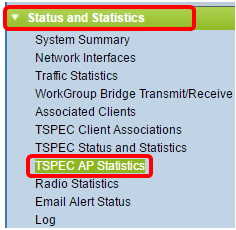View Traffic Specification (TSPEC) Access Point Statistics on the Wireless Access Point (WAP)
Available Languages
Objective
The quality of real-time applications like VoIP and video streaming over Wireless Local Area Network (WLAN) can be poor because of an unstable wireless link. This is the reason why there is a need to prioritize network traffic by enabling Quality of Service (QoS).
Traffic Specification (TSPEC) is sent from a QoS-capable wireless client that requests for a certain amount of network traffic from the Wireless Access Point (WAP) for the traffic stream (TS) it represents. The WAP then decides whether the request is acceptable or not and provides its decision to the client. The client can start the high-priority communication only when the WAP approves it. This prevents any kind of collision and prevents congestion of the wireless link and thus keeps the communication quality good.
This document helps to view and understand information about the voice and video traffic streams on the WAP121 and WAP321 access points.
Note: To know how to view information about TSPEC Status and Statistics, click here. To know how to view information about TSPEC Client Associations, click here.
Applicable Devices
- WAP100 Series
- WAP300 Series
- WAP500 Series
Software Version
- 1.0.6.5 — WAP121, WAP321
- 1.0.2.8 — WAP131, WAP351
- 1.0.1.7 — WAP150, WAP361
- 1.3.0.3 — WAP371
- 1.2.1.3 — WAP551, WAP561
- 1.0.0.17 — WAP571, WAP571E
View TSPEC Access Point Statistics
Note: Appearance of the images may vary depending on the exact model of your WAP. The images used in this article are taken from the WAP321.
Step 1. Log in to the access point web-based utility and choose Status and Statistics > TSPEC AP Statistics.

The following information is displayed in the TSPEC Statistics Summary for Voice ACM table. The Audio Compression Manager (ACM) is a Windows software that is used to manage media files on a network. It is stored with .acm file extension.
- Total Voice TS Accepted — The total number of voice traffic streams accepted by the AP.
- Total Voice TS Rejected — The total number of voice traffic streams rejected by the AP.

The following information is displayed in the TSPEC Statistics Summary for Video ACM table:
- Total Video TS Accepted — The total number of video traffic streams accepted by the AP.
- Total Video TS Rejected — The total number of video traffic streams rejected by the AP.

Step 2. (Optional) To display the current information, click Refresh.

You should now have successfully viewed information about the TSPEC Access Points Statistics on your wireless access point.
Revision History
| Revision | Publish Date | Comments |
|---|---|---|
1.0 |
13-Dec-2018 |
Initial Release |
 Feedback
Feedback